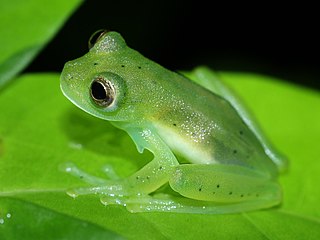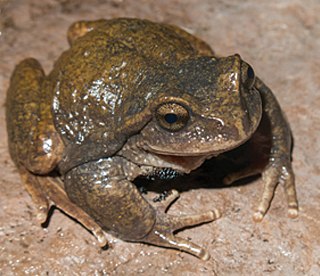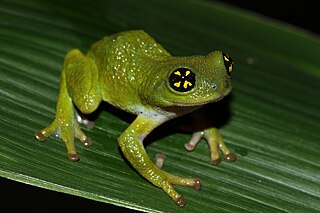
Darwin’s frog, also called the Southern Darwin's frog, is a species of Chilean/Argentinian frog of the family Rhinodermatidae. It was discovered by Charles Darwin during his voyage on HMS Beagle. on a trip to Chile. In 1841, French zoologist André Marie Constant Duméril and his assistant Gabriel Bibron described and named Darwin's frog. The diet of R. darwinii consists mostly of herbivore invertebrates. R. darwinii is currently classified as an endangered species by the International Union for Conservation of Nature.

Alsodes is a genus of alsodid frogs found in Chile and Argentina. It is the most species-rich frog genus in Patagonia. Common name spiny-chest frogs has been coined for them.

Eupsophus is a genus of frogs in the family Alsodidae. They are sometimes known as ground frogs. The genus is endemic to Patagonia. Eupsophus is the second most species-rich frog genera of Patagonia. These frogs are restricted to forested areas at southern latitudes.

Leptopelis is a genus of frogs in the family Arthroleptidae. They are found throughout Sub-Saharan Africa, excluding Madagascar. It is placed in monotypic subfamily Leptopelinae, although this subfamily is not always recognized. They have a number of common names, including forest treefrogs, tree frogs, leaf-frogs, and big-eyed frogs.

Phyllobates bicolor, or more commonly referred to as the black-legged poison dart frog, is the world's second-most toxic dart frog. Under the genus Phyllobates, this organism is often mistaken as Phyllobates terribilis, the golden poison frog, as both are morphologically similar. However, Phyllobatesbicolor is identifiable by the yellow or orange body and black or dark blue forelimbs and hindlegs, hence the name black-legged dart frog. Phyllobates bicolor are commonly found in tropical forests of the Chocó region of Colombia. The diurnal frogs live along the rainforest ground near streams or puddles that form. Notably, P. bicolor is a member of the family Dendrobatidae, or poison dart frog. P. bicolor, along with the rest of the Phyllobates species, produce a neurotoxin known as a batrachotoxin that inhibits specific transmembrane channels in cells. Due to this highly deadly toxin that the frogs secrete, many indigenous groups of the Colombian rainforest have extracted the toxins to create poison tipped darts used for hunting. During the breeding period, P. bicolor emits high pitched single notes as a mating call. As in all poison dart frogs, it is common for the father of tadpoles to carry the offspring on his back until they reach a suitable location for the tadpoles to develop. P. bicolor is an endangered species according to the IUCN red list. Currently, deforestation, habitat loss, and pollution pose the biggest threat to the species. Limited conservation efforts have been attempted to prevent further damage to the species. Despite this, there are still institutions such as the Baltimore National Aquarium in Baltimore, Maryland and the Tatamá National Natural Park in Colombia that are engaged in P. bicolor conservation efforts such as captive breeding.

The Andes giant glass frog is a species of frog in the family Centrolenidae. It is found in the Cordillera Oriental of Colombia and the Mérida Andes and Serranía del Perijá of Venezuela.

Colostethus pratti is a species of frog in the family Dendrobatidae. It is found in the northwestern Colombia and Panama, possibly also in southeastern Costa Rica. It is sometimes known as the Pratt's rocket frog. Colostethus pratti is named after Antwerp Edgar Pratt, an explorer who collected the type series.

Alsodes hugoi is a species of frogs in the family Alsodidae. It is endemic to Chile and only known from its type locality, Río Lircay, in Alto de Vilches, Talca Province, on the western slopes of the Andes. The specific name hugoi honors Professor Hugo Campos Cereceda, for his "remarkable contributions to the development of the natural sciences in Chile".

Eupsophus emiliopugini is a species of frog in the family Alsodidae. It is found in the temperate Nothofagus forests of Chile between 40°50'S and 45°20'S, and in the Lago Puelo National Park, Chubut Province, Argentina. The specific name emiliopugini honors Professor Emilio Pugín, for "his contribution to knowledge of the reproductive biology and development of the Chilean frogs". Common name Emilio's ground frog has been coined for the species.

Eupsophus roseus, the rosy ground frog, is a species of frog in the family Alsodidae. It is endemic to Chile. Its natural habitats are temperate forest, rivers, swampland, and intermittent freshwater marshes. It is threatened by habitat loss.
Eupsophus vertebralis also known as the Valdivian ground frog, is a species of frog in the family Alsodidae. It is found in Argentina and Chile. Its natural habitats are temperate forest, rivers, and intermittent freshwater marshes. It is threatened by habitat loss.

Insuetophrynus is a monotypic genus of frogs in the family Rhinodermatidae. The sole species is Insuetophrynus acarpicus, also known as Barrio's frog. It is endemic to Chile and only known from few localities on the Valdivian Coast Range between Chanchán in the Los Ríos Region in the south and Queule and Colequal Alto in the north; the fourth locality is Mehuín, which is the type locality. The altitudinal range is 50–486 m (164–1,594 ft) asl.
Telmatobius dankoi, also known as the Loa water frog, is a species of critically endangered aquatic frog in the family Telmatobiidae. It is endemic to Chile and is only known from its type locality near Calama, in the El Loa province. Only 14 individuals are known from captivity following the destruction of its habitat prior to 2019, so it may already be extinct in the wild. However, it is doubtfully distinct from Telmatobius halli and thus may not be a distinct species.

The Mozambique rain frog, also known as the flat-faced frog, is a species of frog in the family Brevicipitidae. It is found in Botswana, Democratic Republic of the Congo, Eswatini, Malawi, Mozambique, South Africa, Tanzania, Zambia, Zimbabwe, and possibly Lesotho. Its natural habitats are dry savanna, moist savanna, temperate shrubland, subtropical or tropical dry shrubland, temperate grassland, subtropical or tropical dry lowland grassland, subtropical or tropical high-altitude grassland, arable land, pasture land and rural gardens.

The palmated chorus frog is a species of frog in the family Microhylidae. It is found in Indonesia and Malaysia. Its natural habitats are subtropical or tropical moist lowland forests, rivers, and freshwater marshes. It is not considered threatened by the IUCN.

Raorchestes chalazodes is a species of critically endangered frog in the family Rhacophoridae. Raorchestes chalazodes is a nocturnal and arboreal species found in the understorey of tropical moist evergreen forest and is endemic to the Western Ghats of India. The specific name chalazodes is composed of the Greek word χάλαζα (chalaza) meaning "lump" and -odes for the derived adjective, reflecting white granulation of the body. It has been observed between 1200 and 1600 meters above sea level.

The Chile Darwin's frog, also called the northern Darwin's frog, is a possibly extinct frog, and one of only two members of the family Rhinodermatidae. It is endemic to central Chile.

Telmatobius chusmisensis is a species of frogs in the family Telmatobiidae. It is endemic to northern Chile and is only known from a number of localities in the Tarapacá Region. The specific name chusmisensis refers to its type locality, Chusmisa.

The Alsodidae are a small family of frogs from South America between Patagonia and southern Brazil. It contains 30 species in three genera. This family, along with several other families, used to be included in the family Leptodactylidae. It was then a subfamily in the family Cycloramphidae, before being recognized as a family first in 2011.

Anomaloglossus kaiei is a species of frogs in the family Aromobatidae, commonly known as the Kaie rock frog. It was named in honor of Kaie, a great Chieftain of the Patamona tribe, who sacrificed himself to the Great Spirit Makonaima by canoeing over the Kaieteur falls in order to save his own people. It is endemic to Guyana where it is known from the Kaieteur National Park and the Pacaraima Mountains. However, as it is found along the Guyana–Brazil border, it is also possibly present in Brazil. This frog shows maternal care: female frogs can provide tadpoles with trophic eggs.


















